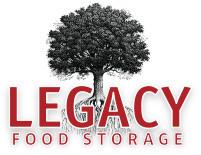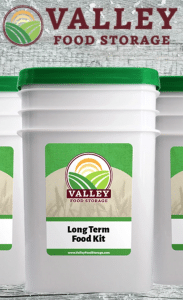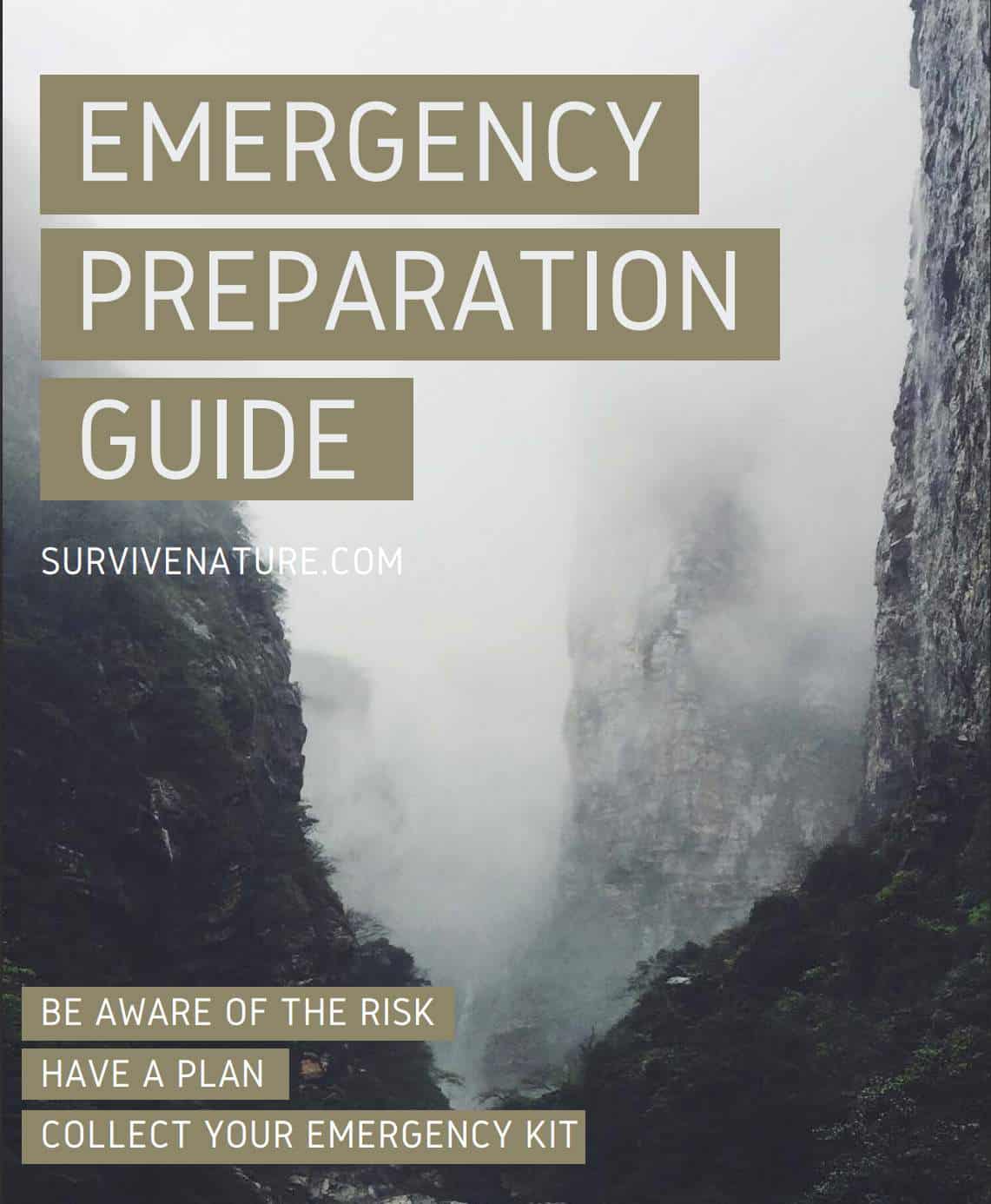Wise choice of survival food kits, particularly in 2023, is an integral factor of successful survival. Think about the nutritious characteristics of the meals you want to put in your backpack: meat, pasta, beef, chicken, and rice will sustain you better than some packs of crackers. To learn more about food survival kit, survival cooking and dining, read the article.
Introduction
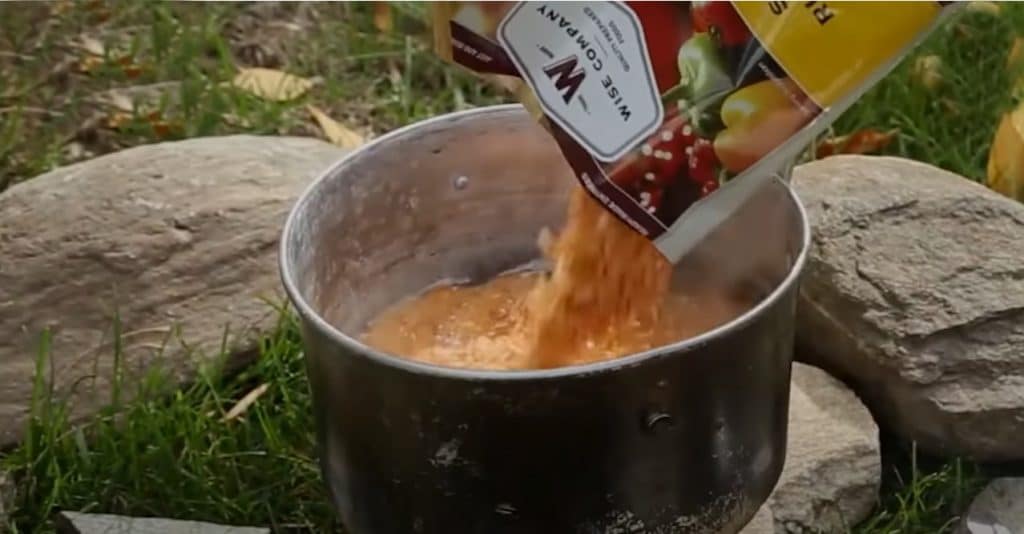
As we have already said, the future is uncertain, and you should know how to take care of yourself and those around you if things get tough. So read our guide to find everything you need to know about emergency food supplies, how to make food storage of your own, how to choose survival food kits, and what crisis kits the market offers.
TOP Best Emergency Food Kits
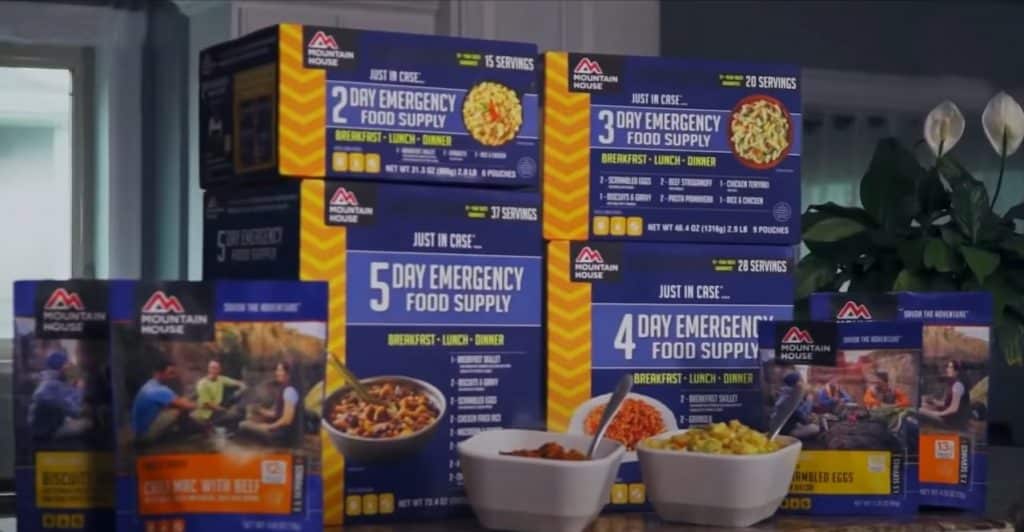
This section will get you familiar with the emergency food supply products and the brands offering them. Below you will find out about the various emergency meal solutions in price, size, and packaging.
1) Mountain House
We chose Mountain House’s products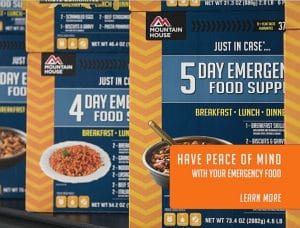
- Mountain House offers freeze-dried food that boasts an even longer shelf life than any other emergency food company can offer. Mountain House products are said to remain eatable and retain their taste for up to thirty years. In contrast, regular emergency food has only a twenty-five-year guarantee.
Mountain House products packaging includes pouches and buckets. Unfornutaley, the company does not have a larger buckets packaging option to make it easier for customers to stock on the emergency food supplies. So if you want to use Mountain House foods as the basis of your emergency food stockpile, you will just have to buy more small-sized buckets.
We will not say that Mountain House foods are too affordable. They are quite expensive, but in terms of quality, the food is definitely worth it.
2) Legacy Food Storage
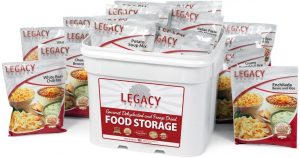
- Legacy Food Storage produces emergency kits that contain over four thousand portions!
Of course, such massive kits are not the only option. The company’s minimal kit starts at only sixty servings but don’t you say you are not impressed.
Survival food enthusiasts claim (and we cannot but agree) that Legacy Food products are perfect for anyone building an end-of-days stockpile in their basement. This is a great combination of quality and price. And even more:
- The company offers free shipping as well!
So there is no way you would pass on the Legacy Food Storage products when building your own long-term emergency food stockpile. Make sure you have the company’s website bookmarked!
Just take a look at these impressive freeze-dried comfort food options the company offers:
- 120-portion bucket;
- 360-portion bucket;
- 720-portion bucket;
- 1440-portion bucket;
- 2880-portion bucket;
- 4320-portion bucket.
And that’s not even all from Legacy Food Storage. This company also offers gluten-free different sized food buckets. Check them out:
- 120-portion gluten-free bucket;
- 240-portion gluten-free bucket;
- 360-portion gluten-free bucket.
As we have already said, Legacy Food may well be your only choice if you decide to stock up on loads of freeze-dried emergency kits to get you through emergency survival hardships that may lie ahead.
But wait, there is something else the emergency food market has in store for you.
3) Valley Food Storage
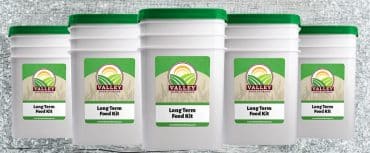
Valley Food Storage packs 72-hour kits in soft mylar bags, but the larger options always come in plastic buckets that are easy to move around and stack onto each other.
Below is the list of the most popular products from Valley Food Storage:
72-Hour Kits
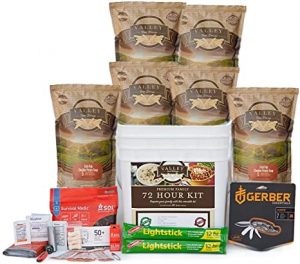
These are the regular three-day emergency kits you may choose to buy to get the first taste of Valley Food Storage production. These kits are affordable and are perfect for a short-term emergency survival menu. Get a few of these to feed your family or friends.
The kits come in thick and tightly sealed mylar bags, preventing moisture and oxygen from getting inside. So there is no way the food will spoil while lying on the shelf.
Thirty-day Kits
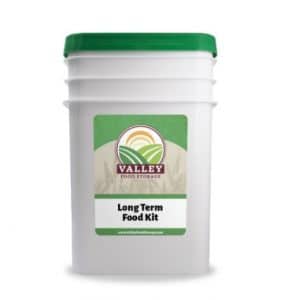
Three-month Kits
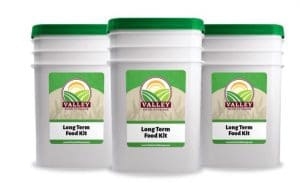
Three-month kits by Valley Food Storage are a good option to start your long-term emergency food stockpile with.
Six-month Kits
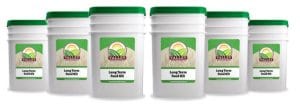
One-year Kits
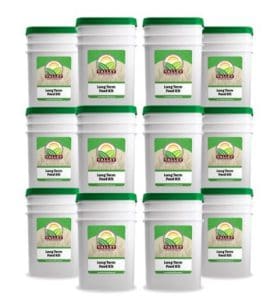
Freeze-dried Meals Subscription Plan
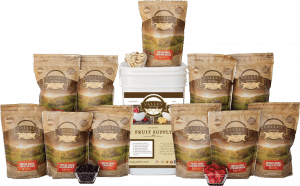
- When searching for emergency food products online, make sure to check product availability on the manufacturer’s website.
- Don’t forget to use other clients’ reviews to learn if there are any complaints and problems such as shipping delays or poor product quality. Also, do reviews of your own to help other customers.
- Don’t hesitate to address customer service for more information on the product you would like to buy. A professional customer service team will always give you all the necessary information on product availability and updates, sales, discounts, subscription plans, purchase & shipping options.
- And finally, when making orders, try to pick meals with various tastes. Remember that in the worst-case scenario, you will have to eat these foods every day. So, in addition to living in a devasted post-disaster world, you would want your day-to-day meals to become another bland routine deprived of any joy.
What is a Survival Food Kit and Why You Might Need It?
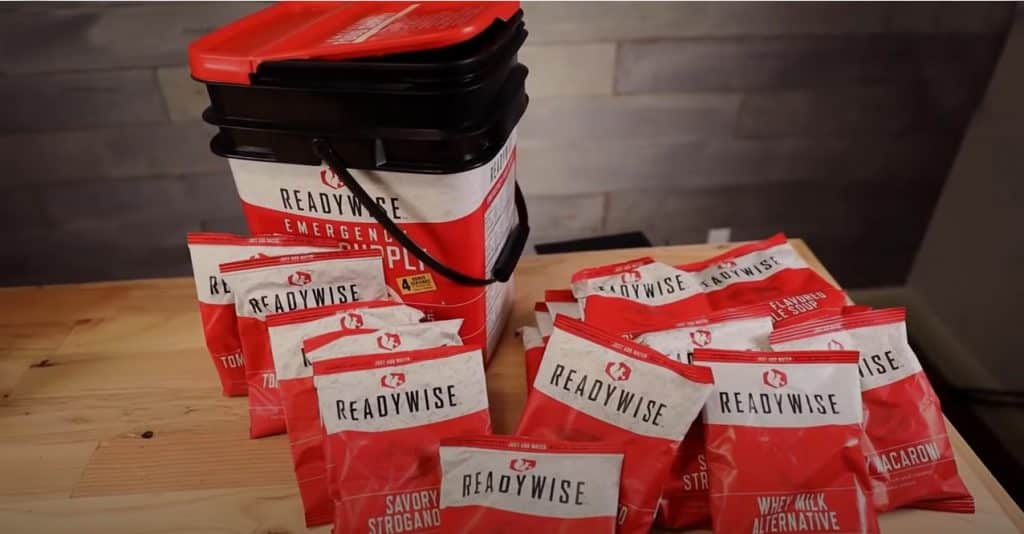
A survival food kit is an emergency collection of foods with a long shelf-life and enough meals to provide a necessary amount of calories per day. Food storage kits vary in sizes and methods of preparation, prices, and packaging options. You can get them in bags or even in buckets.
Emergency food supply kits are of great importance. Since you never know what to expect of the future – be it a devastating natural disaster or a military conflict leaving thousands and millions without shelter and supplies – you will feel a lot safer and confident having a long term emergency food storage filled with different types of survival meal kits.
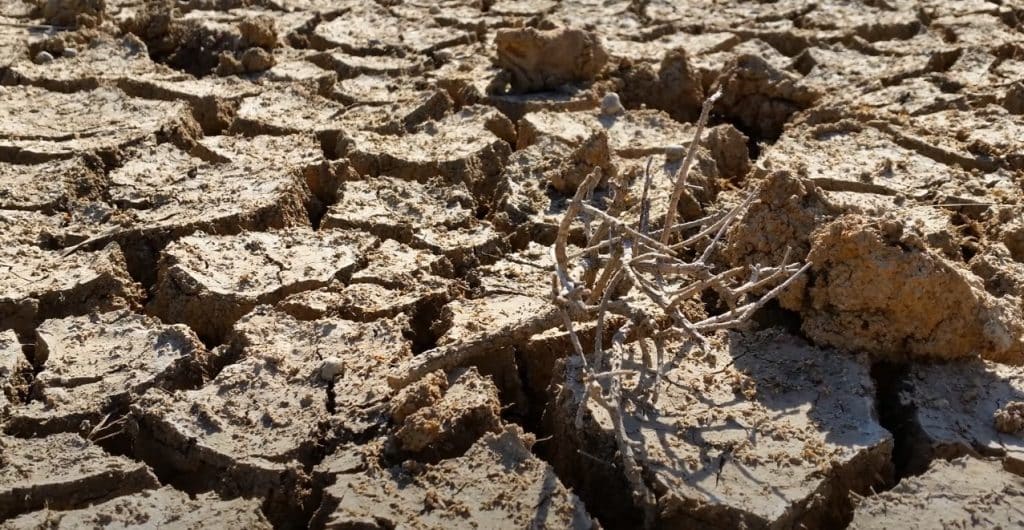
The more your survival food storage is, the better. Even though survival specialists advise having a 72-hour emergency food supply, our recommendation is to take it to the maximum if you are concerned about your safety. And you should be. Otherwise, you wouldn’t be reading this post.
Human history (even the recent one) knows many terrifying examples of famines taking millions of lives. We are not scaremongering, but we believe that everyone should have enough food supplies to last the longest period of hard times should something terrible happen to the world around us.
Take our word for it. If things get tough, resulting in another famine, you will thank us for being so persistent on how important it is to stash as many emergency food supplies as it is even possible. Dying from starvation is not your option!
Read on, and you will learn how to boost your emergency preparedness by investing in survival food storage that will let you, your family, and friends stay alive even during a worst-scenario event.
Most Important Survival Foods Criteria
Unfortunately, there are no universal criteria for cooking in a survival situation. They are all different.
In one situation, you may need an already assembled bag or backpack of supplies in case of emergency, leaving your home. For example, when evacuating from a fire. Bags should be comfortable, lightweight but contain everything you need for the first time, such as a small version of your emergency food storage.
Or your home can be cut off from the rest of the world by snow debris, and electricity can be damaged. Then you will need an emergency food supply that you can cook and eat without using electricity.
Or maybe the flood will spoil all uncleaned food with water pollution. Therefore, they must be stored in sealed containers to prevent your emergency food supply from poisoning.
Unfortunately, it is impossible to prepare for all survival situations, but the basic guidelines are similar.
When stocking food supplies, we advise our readers to pay attention to the following parameters:
- nutrient content of food, your body needs to get enough fat, protein, vitamins, and calories per meals;
- the shelf life of the food, the longer, the better, choose products for long term storage;
- product flexibility, that is, the ability to use them in different dishes, make different emergency food meals;
- your taste preferences, you should like the emergency food that you have;
- food processing requirements, ideally, should not be required.
Nutrient-Rich Foods
It is important to think about your emergency food supplies to provide the body with sufficient nutrients. Beans are great for this.
Be sure to stock up on beans; also, rice works well with beans. In this combination, the emergency food will provide the body with protein flow. Another plus, rice and beans have a long shelf life. If you are not a fan of beans, we suggest paying attention to garbanzos, lentils, or red kidney beans. You can find such products at Augason Farms. Now the company does not have shipping delays.
Long-Lasting Food
Make sure that all products you choose for emergency food supplies have a long shelf life. Perhaps this is the most important criterion for choosing survival food for your food storage.
Ideally, the shelf life of food without a refrigerator should be more than a year. A year shelf life might sound enough for you, but many products can have significant long term storage. Always keep track of what you have in your emergency food storage. If something’s expiration date is coming to an end, do not forget to replace the product with a new one because you never know when an emergency begins and for how long you may need your emergency food supply.
Pay attention to freeze-dried meals, food stored in cans.
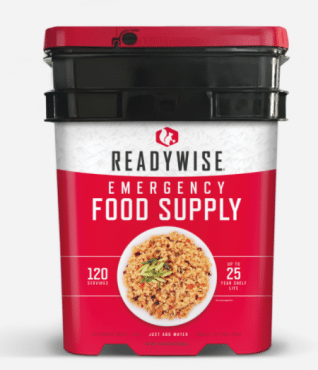
Emergency Food, Legacy Food Storage, or Valley Food Storage. They produce a wide variety of freeze-dried meals and have special emergency meal buckets, such as breakfast buckets.
Freeze-dried food may include vegetables, meats, fruits, and even instant coffee. Freeze-dried food is restored when it is placed in water. Someone may think that this type of emergency food is not healthy. But that is not true. Freeze-dried food gets its nutrients back with the water.
Flexible Food
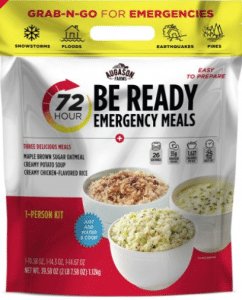
Monotonous food will bore anyone. You may think that when you find yourself in an emergency survival situation, you will not be up to a variety of food, but believe me, this is important, not only for mood but also for the body’s health. Therefore, we
advise you to choose products that can be used in different ways.
For example, consider butter powder or dried powdered milk. It seems like a boring and mundane product, but it is not. Powdered milk can be used to make cheese, pudding, yogurt, and even bread.
Whey powder is good emergency food, too. Whey powder can be used to prepare biscuits, bread, protein-rich drinks.
Flexible foods are also great because they can barter other supplies or equipment.
Take Food You Love
Survival situations are undeniable stress for humans. Foods that you don’t like or don’t know how to cook are stressful too. Do not ruffle your nerves in a difficult situation. On the contrary, you can calm and please yourself with food.
We advise you to prepare “comfort food,” this is food that you eat every or almost every day, which is comfortable and pleasant for you. Take some butter powder; you will not regret it.
When times are tough, you need to cheer yourself up not to go crazy, and food is great for such purposes.
If you are a cheese fan (like us), then stock up on cheese. For example, you can buy cans of freeze-dried mozzarella cheese. Buy your favorite cookies or dried fruit. Besides, fruits contain sugar and calories, and cheese contains essential fats. So delicious food will also be good for you.
Do not stock up on foods that you have never eaten in your life. You may simply not like it. We also do not recommend taking food that makes it difficult to prepare. Survival situations are not the time to be Gordon Ramsay.
Food that doesn’t need cooking
Survival situations vary but assume that you may not have a place to cook it first or may not have time for it. If you need to leave the area quickly, you will not want to stop installing a fire or warm water over a fire. Therefore, most emergency food supplies should be foods that do not require special preparation before consumption.
A good example of emergency survival food is military MRE meals, which do not require heat. We recommend everyone to stock up on such food.
Basic Survival Food Groups
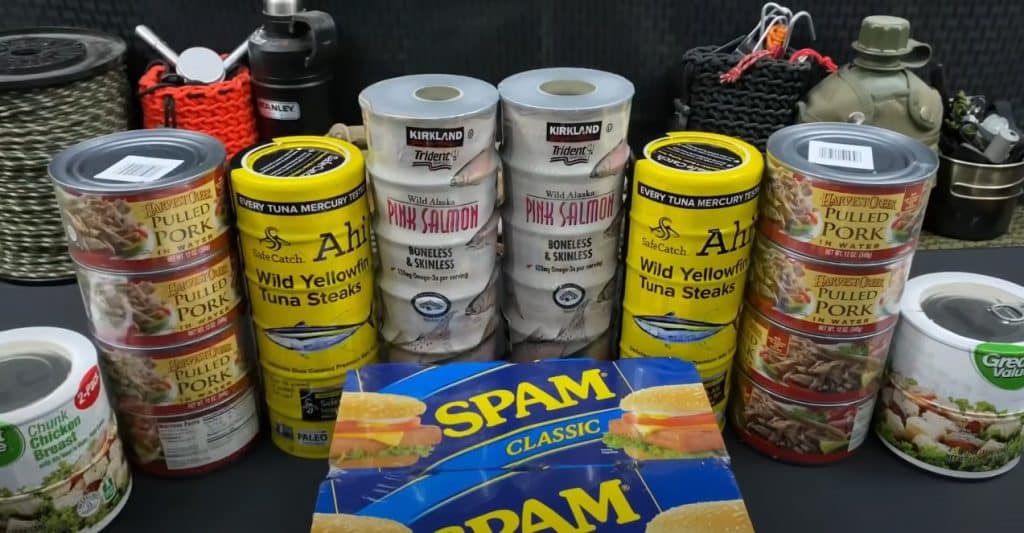
All emergency food supplies can be divided into major groups. To successfully compile your emergency supplies, you need to stock up on each group’s food for your emergency food storage.
Prepare a special shelf in your emergency food storage space, as you will have to stock up in bulk.
Make sure you have purchased special equipment that you may need to process and prepare food.
When compiling a list of emergency food supplies, consider all the selection criteria that we consider in our article above. Your diet must be balanced. Make a shopping list and head to the grocery store or buy foods online, as many items need to stock up.
1. Drinks
A person can live without food for some time, but death will occur in about 2 days without water. Water is the most important component of human nutrition, so it is essential to stock up on bottled drinking water.
You can also use clean water for cooking survival meals such as porridge or rice, or freeze-dried meals. And even if you have nothing to heat the water on, you can pour, for example, oatmeal overnight, and in the morning, you will have delicious food.
In addition to stocking with regular clean filtered water, you can prepare powder mixtures that, when mixed with water, create protein or high-calorie drinks. They are convenient to use to maintain the required amount of nutrients in the body.
For example, the Tang orange drink will saturate your body with your daily vitamin C. This is very useful for emergencies, as you may not have time to calculate vitamins or find them from many sources, but you can always drink one drink.
The advantages of powder mixtures are that they can be used as a barter item; they are lightweight and can be carried with you.
Also, stock up your survival food kit on medicinal teas. They can be used for medicinal purposes or sedation.
Check out Valley food storage options or Legacy Emergency Food, and Mountain House Review; these are among the best across the globe.
2. Fish
Fish is a great source of protein, healthy fat, omega-3, and other nutrients. Be sure to diversify your diet with fish and fish products.
Stocking up on fish may still be on a budget. Canned fish is good for emergency food supplies. Pay attention to canned sardines, tuna, herring. A pleasant bonus is that these products can be eaten directly from the can; they do not require any processing and can be an independent dish. If the situation allows you to eat canned fish with rice and are real fans of this combination, we hope you will like it.
3. Meats
Meat is an excellent energy source and protein for the body (if you are not a vegetarian). In survival situations, it is an important part of a person’s diet. At the same time, meat is not as easy to stock up as water or dry food, meat meals are more difficult to store, and it has a short term shelf life. The meat should be stored ready to eat. Therefore, it is difficult to stock it up for future use. At some point, you will have to either go hunting or raise livestock.
- Raising animals
Raising animals as a source of meat, of course, requires special skills. Animals must be fed and kept in acceptable conditions. This is not possible in all situations of survival. If this is acceptable in your situation, we advise you to have goats, rabbits, and chickens. In addition to meat, you can use chicken eggs or goat’s milk. Raising animals can be very useful in a long term survival situation when your prepper food will come to an end, but you still need to feed yourself and your family.
- Pemmican
We think pemmican is the most amazing meat product for survivalists. Under the right storage conditions, this meals’ shelf life can be up to 50 years. Agree; it’s just amazing. And the storage conditions are not as difficult as you might think. You need to store it in containers in a cool, dark place.
You can buy ready-made pemmican or cook your own. Pemmican is a mixture of dried meat and fat formed into bars. This meat is full of calories.
- Freeze-dried meat
Another option is to stock up on freeze-dried beef or chicken. For consumption, you need to rehydrate it. This is an amazing survival food as it has a shelf life of 25 years.
We also recommend stocking up on ready-to-eat meat products such as spam, chili, or ham. All types of these meats are available in cans, which makes storage convenient. You can buy at least 10 cans for each family member.
4. Nuts, Legumes, and Grains
Our body needs protein, it can be obtained from meat or fish food, but it is also rich in nuts, legumes, and grains. In combination, they can provide the required amount of protein. However, these foods are easier to store than meat, as they are dry foods with a long shelf life.
These products require special preparation. There are countless food options to prepare. You can make a hardtack that will last for decades if you store this food properly.
You can make bread by chopping red wheat berries and adding beans or nuts to create a special flavor. The options are endless and only limited by your imagination.
The advantage of this food is its low cost. You can buy a lot of packs of pasta and cans of beans at once. These products can be stored for a long time, and at the same time, saturate the body with the necessary calories and protein.
Peanut butter also has a long shelf life and does not require any heat treatment. You can just spread it on a cracker.
You can also use some of the foods for germination. Stock up on wheat, garbanzo beans, and sunflower seeds. They can sprout even in low light, and you will have fresh greens and fresh food.
5. Veggies and Fruits

Unfortunately, there is no point in storing fresh fruits and vegetables, as they have a short shelf life and begin to rot very quickly.
Therefore, you can store dried fruits. Their storage does not require complex special conditions. Dried fruits can be consumed either simply or by adding them to different dishes, such as bread or pemmican.
You can simply mix dried fruits, nuts, and grains and eat this mixture rich in beneficial micronutrients. Such a dish does not even require heating or processing. Just mix and eat.
To extend shelf life, you can use these products in your daily life and replace them with new ones in your emergency food supply.
Like most preppers, you can stock up on vegetable and fruit seeds. From them, you can grow fresh food. But of course, this option is not available in all survival situations but will be useful in a long-term emergency.
6. Dairy
Dairy products are the hardest to prepare. Without proper storage, cheese and milk will go bad quickly. Therefore, we advise you to stock up on powdered milk, from which you can make yogurts and cheeses. Practice your cooking ahead of time, and write down the recipes.
Another solution is to have a goat or a cow, then you will always have fresh milk, and you can cook dairy products. Or you can sell milk, which can be a good income.
Of course, you can buy canned cheese, but you will not be able to stock up on them for a long time, so if you have limited space in the pantry, it is better to take something with a longer shelf life.
7. Oils
The choice of oils can be quite varied. This is olive oil, sunflower oil, hemp, and so on.
The oil is good for our blood vessels, skin, and overall healthy appearance of the body. It is used for cooking and gives food flavor.
Many oils can be used for long term storage. For example, canned oil has more than a year shelf life, while coconut oil has a shelf life of 7 to 15 years.
We advise everyone to stock up on 10 cans of coconut oil. It is easy to store, remains solid at room temperature, tastes good, is rich in nutrients, and has antibacterial properties.
Besides cooking, it is used for the body. This oil can work as a body cream, hair conditioner, or balm. It can be used every day.
Coconut oils are truly versatile products that you need to add to your emergency essentials.
We advise you to try out a couple of recipes with this oil before the survival situation. Better to be prepared. This will not let you get confused.
8. Spices
Excess salt is harmful to the body, but it adds flavor to dishes in a mild amount. It can also be used for preserving foods. For example, you can pickle cucumbers to prolong their storage.
In ancient times, salt was used instead of money. Who knows, maybe these times will return.
The rest of the spices can also be used for these purposes, they do not take up much space in your pantry, and you do not need to put a lot of them when cooking, so you can definitely buy several bags of spices and salt.
9. Sweeteners
Some might think that sweeteners are not emergency essentials, but they actually give the brain energy and, of course, make food tastier.
Sugar is easy to store, its shelf life is infinite, and it can also be used to preserve berries and fruits.
You can stock up on honey, you can add it to cereals, pemmican, make energy bars with it, but someone just prefers to eat it with a spoon. Honey is also suitable for long-term food storage. It is even possible that its shelf life is infinite.
10. Alcohol
Do not be surprised at this point. We do not advise you to forget about the situation of survival and just start drinking. Alcohol may be needed for other purposes.
Of course, a bottle of wine can relax your nerves, but that is not what we are talking about.
Alcohol can be used medicinally to sterilize wounds, but it should be distilled spirits or vodka.
Alcohol is also used to preserve fruits and vegetables.
You can even learn how to make moonshine, wine, and beer yourself and sell them. So alcohol can even feed you.
Choosing a Survival Food Kit
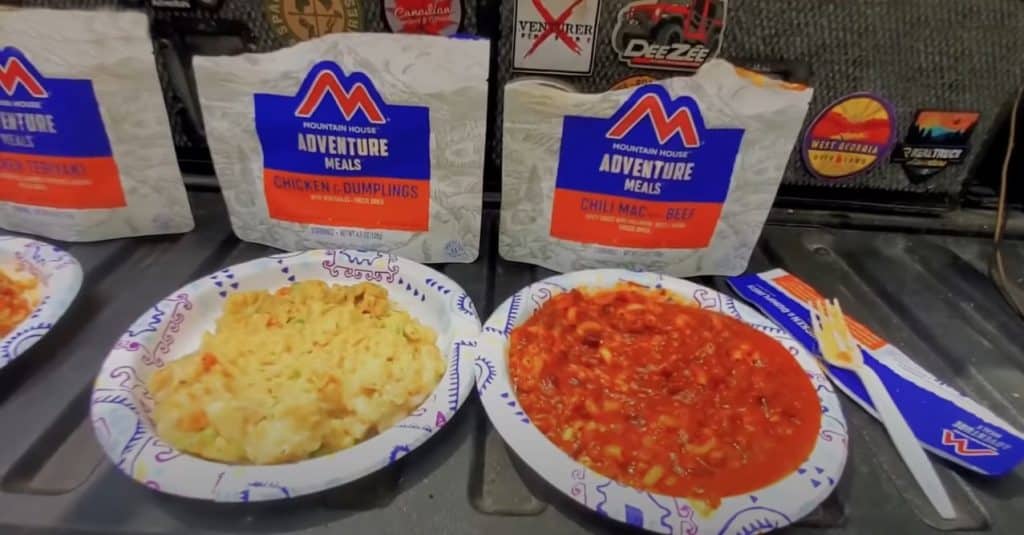
To make things easier, we broke down this topic into three separate segments:
- Preservation options;
- Sealing and storage options;
- Prices.
1) Food preservation options
Dehydration is probably the first thing to come to mind when speaking of product preservation techniques. Technically speaking. Dehydration is the process of “drying” foods to remove as much water as possible. This works well, and keeping some dehydrated products in your emergency storage is fine. But we would not recommend getting too many of those. After all, dehydration is not the best way of preserving food products, especially if you want to build long-term food storage.
Freeze-drying. Freeze-dried food is the best long-term option for emergency food supplies. Freeze-drying does pretty much the same as dehydration, but it does it even better. Freeze-drying removes all water from the food using low temperatures and sublimation. Thanks to that, freeze-dried meals and freeze-dried fruits have a long shelf-life and can be stored up to decades and still be fit for human consumption.
Another nice feature of freeze-dried meals is that they usually retain their initial texture. Freeze-dried food is easy to prepare – just add it to the boiling water. As soon as the food absorbs water, it will taste and feel just like the original food. One more thing, these meals need no salt or pepper to make them tastier.
Ready-to-eat meals. Read-to-eat meals or MRE products are somewhere in between the previous two options. They are not as quickly perishable as regular fresh products but have a much shorter shelf-life than freeze-dried food. For instance, you can store MRE meals for five years maximum. But freeze-dried food will stay edible for 25 years and more.
Like freeze-dried products, MRE meals don’t require salt, pepper, or other spices to enhance their taste.
- We recommend getting more freeze-dried food for long-term emergency food supply storage, adding some amount of MRE meals to use in the first weeks of a post-disaster period. As for dehydrated products, buy them in moderation. Remember that they have a relatively short shelf-life, so you will have to consume them first.
2) Storage options
There are basically two ways to store emergency food supplies:
- Mylar bags;
- Thick plastic containers.
Mylar bags. There is no way to imagine proper long-term food storage without mylar bag packaging. The history of Mylar bags starts sometime in the middle of the 20th century with the invention of BoPET film or “space blankets” as this film in no time became used in NASA’s space programs. Mylar bags are thin bags made of this special BoPET film that will not let air inside.
Thanks to this feature, Mylar bags are perfect for storing food products. Because if there is no air inside a package, there is no oxygen and moisture either, so the food stays safe. Why? Because oxygen and moisture are the breeding grounds for mold. And mold is what spoils food products. Take away these two elements – moisture and oxygen – and there will be no chance for mold to appear and ruin your food storage. That’s what you need Mylar bags for.
When you put freeze-dried food in them and seal them up, you can rest assured that moisture and oxygen will not find their way through. And here’s another tip: try putting some oxygen-absorbing packets inside as well. They will serve as an extra precaution.
But here’s something you should know about: mold is not the only thing you will have to think of. What can harm your food supplies from the outside are vermin. Mylar bags’ material is not a serious obstacle for them. Unfortunately, many people don’t pay enough attention to this, but you should. To make your Mylar bag emergency food supplies completely safe, use thick plastic containers.
Plastic Food Containers. Store your Mylar bags in plastic containers with thick walls. For instance, use plastic buckets.
What’s great about this option is that plastic buckets will not only prevent vermin from feasting on your supplies but will let you save up tons of space. You can stack containers on each other and have a lot of spare room in your pantry. Learn how to make sugar at home and store it properly.
Also, plastic containers usually have sturdy handles. You may not be planning to move any time soon, but since we’re talking about long-term storage, which means years and even decades, you would like to have the possibility to carry heavy tubs and buckets of emergency foods with ease. So handles rule!
3) Price
The survival kits market is huge. Manufacturers compete, trying to lure as many clients as they can. They use discounts, sales, and commercial tricks like claiming their product is the best deal a customer can think of. Be careful because you may get easily misled.
When choosing an emergency food supply kit, price matters, but you are at risk of compromising the quality in an attempt to save a couple of bucks. Choose wisely and carefully. After all, emergency foods are a long-term investment that would pay years after you’ve purchased them. So as much as the price matters, take your time and choose the best quality emergency meals for your long-term food storage.
Going DIY?
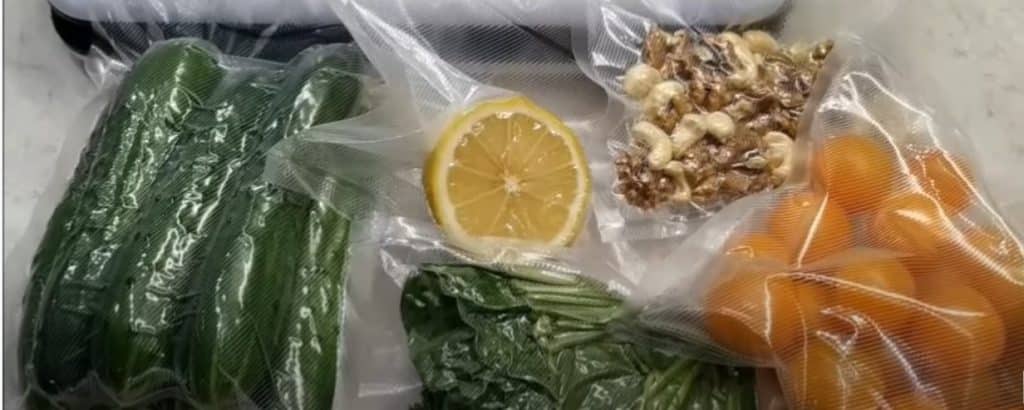
Here’s the question we often hear: “Can I build an emergency food supply storage just by myself?”. Understandable. Many people think that going DIY is the best way to do things and save up some cash along the way. And while this may be true for certain projects, building long-term storage of emergency meals is not the case.
We will not try to convince you that a DIY emergency food stockpile is an impossible concept. It is possible, and you can do it, but you will have to get prepared to spend some extra cash.
For instance, a home freeze-drying machine will cost you sixteen hundred dollars, which is not the most expensive dryer. A food dehydrator is a more affordable option. But as we mention before, dehydrated products have a shorter shelf life and cannot serve as the basis of your survival food storage.
Another tip is to share expenses with your friends. This is a good idea, especially if you live next door and pursue the same goals.
The next thing on your survival food list is buying mylar bags, food buckets, and oxygen absorbers. There is no way you can DIY any of those so that these expenses will add to the previous ones. So most likely, you will give up on the idea of getting yourself a personal freeze-dryer focusing on buying freeze-dried foods from a Mountain House, Backpackers Pantry, Wise Company, Survival Frog, or some other emergency food supply company.
Or you can decide to stick with only dehydrated foods. This is not a bad option, but you should keep in mind that these non-perishables are not forever. Dehydrated foods cannot last for decades as freeze-dried fruit and meals do. So if dehydrated supplies are your choice, be sure to rotate these products.
Food rotation is crucial because it ensures that no food will go to waste. What you will have to do is follow the expiration date of your stocked foods and consume them in a particular order beginning with those you bought earlier. This is not rocket science, but it surely takes certain skills to organize the whole process.
So, as you see, DIY emergency food stockpile is not impossible, but it is not an easy matter either. It will always require whether time or money investment. And if you don’t feel confident enough about venturing into this endeavor, we encourage you to go traditional and check out our picks of top emergency food supply offers on the market.
Why Do I need to Prepare Foods in Advance?
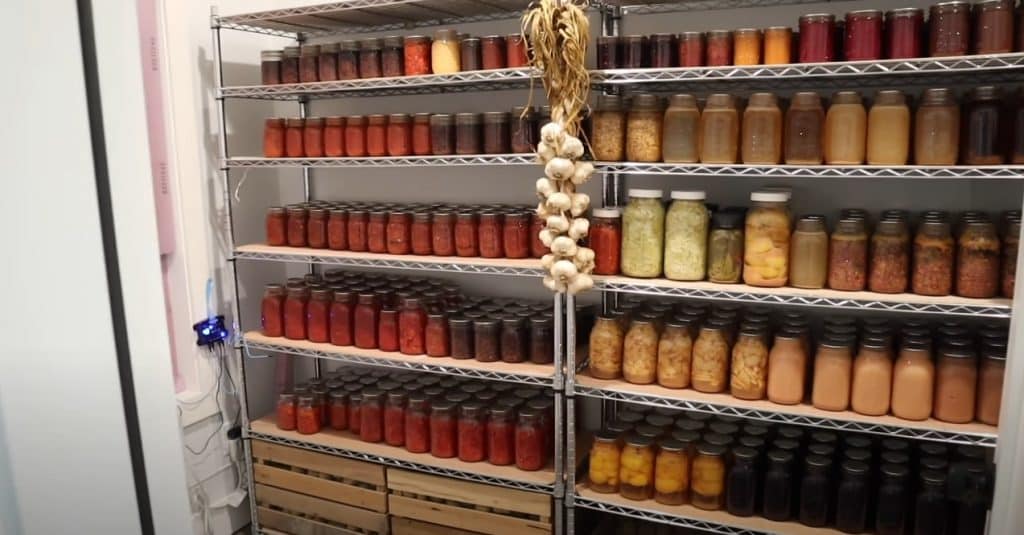
Once again, frozen food is a poor choice for emergency survival food. Even if the power goes out for a while, all your fine food will go bad, and you will not have any emergency essentials and food supplies.
You might think that if you have a backup generator, then using it to keep your freezer or refrigerator running would be a good idea. But this is not the case. First and foremost, when embroidering begins, you want to keep your home warm and dry, not a freezer or microwave ovens. So do not freeze your favorite mashed potatoes for emergency food supply. That may not be useful at all.
Therefore, we strongly advise you to build a dedicated pantry to store the survival food supplies that can save you and your family life. By the way, it might be a good idea to create a common pantry with your relatives, family, your company of friends. This way you can store more food. But these should be people you trust.
Choose emergency food responsibly. Use our advice. Also, stock up on survival food kits that you may require.
Look for ready-to-eat foods, but also do not neglect foods that require special handling or preparation before eating and foods that can be used to grow new ones. This will be useful in a long term emergency survival situation to feed you and your family.
Also, you may prepare buckets of short term emergency food that can be used in three months. You can find special short term emergency food buckets on the websites that we mentioned above. They also have special vegetarian buckets.
Real Preppers Takeaway
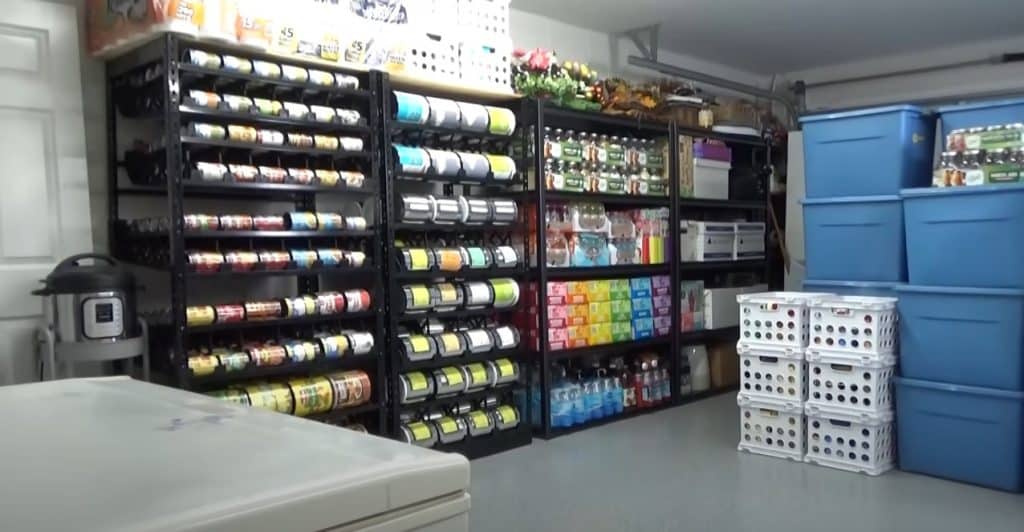
Building a long-term emergency food stockpile takes a fair amount of time and money investment. That’s why you must be one hundred percent motivated to go all the way and don’t stop halfway through. Our recommendation is to think of it as insurance. All those emergency meals you plan to buy today may or may not serve you in the future. But either way, you’re winning.
Should the world end in a global scale catastrophe, taking away our everyday life, you will not have to worry about what you and your family will eat. With freeze-dried products tightly sealed down in your basement, you have all the necessary food supplies to keep you going every day.
Or maybe nothing of the sort will ever happen, and our world will be just fine. In this case, you will just have loads of high-quality non-perishable foods you can feast on because modern-day emergency meals are delicious and retain their taste for years.
Anyways, investing in emergency survival storage is never a waste. And if you are concerned with self-reliance and survival preparedness, building long-term food storage of your own should be just as necessary as stocking up on salt and matches, water filters, medical supplies, warm clothes, hand tools, and any other survival gear imaginable.
Be well and be prepared!
Frequently Asked Questions – FAQ
What is the Best Survival Food Company?
Among the top three emergency food companies are Valley Food Storage, Legacy Food Storage, and Mountain House. But those are not the only trustworthy brands providing quality freeze-dried or dehydrated meals. Here is the list of other emergency food brands on the market. Feel free to use quick links to visit their website for more information:
- ReadyWise (formerly known as Wise Company) – https://readywise.com
- My Patriot Supply – https://mypatriotsupply.com
- Backpackers Pantry – https://backpackerspantry.com
- Augason Farms – https://www.augasonfarms.com
What are the Best Emergency Food Kits?
An average person should gain at least fifteen hundred calories per day. With that in mind, each quality emergency meal kit should contain enough food to keep an average person going every day during the survival period.
Emergency kits come in the two main packaging options like vacuum mylar bags or plastic buckets. The latter is used to pack a large quantity of smaller food packages planned for long-term emergencies.
The aforementioned emergency food supply companies offer high-quality products with the most popular, including:
- Breakfast Bucket by ReadyWise (formerly known as Wise Company). This emergency breakfast bucket packs 120 portions of high-quality and nutritious food and makes for a perfect survivalist morning meal. The breakfast bucket includes vacuum bags with maple brown sugar oatmeal, apple cinnamon cereal, crunchy granola, and strawberry granola crunch. Wise Company is among the most trusted brands globally that offer quality emergency food solutions for long-term emergency storage.
- Powdered eggs by Augason Farms. Powdered eggs are an amazingly nutritious dried product that has been around for over a century. This dried food no worse than regular eggs, but it’s a lot more convenient to store due to its weight and volume. And, in case you don’t know, you can store powered eggs for up to ten years. There are many dried eggs on the market, but we chose Augason Farms’ powdered eggs due to multiple positive reviews.
- Creamy potato soup is another Augason Farms’ product on our list. A 25-portion pack contains fifty-five hundred calories and has a 10-year shelf-life, making it a perfect long-term emergency food to keep the whole family well-fed.
- A 32-portion mashed potatoes kit by My Patriot Supply. Nothing makes for home kitchen comfort like a plate of mashed potatoes does. And with this kit by My Patriot Supply, your emergency shelter will always feel like home.
What is the Best Survival Food With a Long Shelf-life?
If you want to stock up on long-term emergency food with the longest shelf-life, look no further than the products by Mountain House. This company produces freeze-dried food that will remain edible for up to thirty years without losing its taste.
How Long Do Emergency Meal Kits Last?
Emergency meal kits can divide into two main categories: short-term and long-term kits. With short-term food supplies, you only have months before the stored meals begin to spoil. In contrast, long-term supplies can last for years and even decades if you store them properly. As of now, the longest period an emergency food can last is thirty years.
How to Make Survival Food Packages?
To make an emergency food supply storage of your own, you will have to get a personal food dehydrator or a freeze-drying machine to make non-perishable food supplies. Both options will be costly. However, a dehydrator is more affordable. But still, if you’re up to go DIY on building an emergency food supply stockpile, you must know that you’re in some serious money investment.
Besides, you will have to stock up on mylar bags, oxygen absorbers, and plastic containers to ensure a long shelf-life for your products.
A DIY emergency food supply storage is impossible, but most people would still find it time-consuming and pretty expensive. Our recommendation is to buy pre-packaged freeze-dried products from reputable manufacturers or trusted retailers like Survival Frog.

